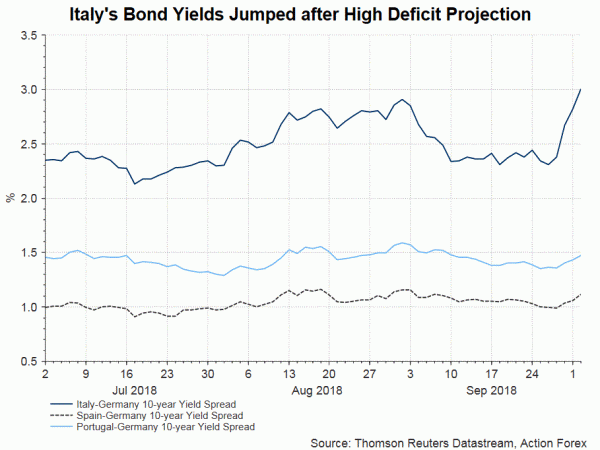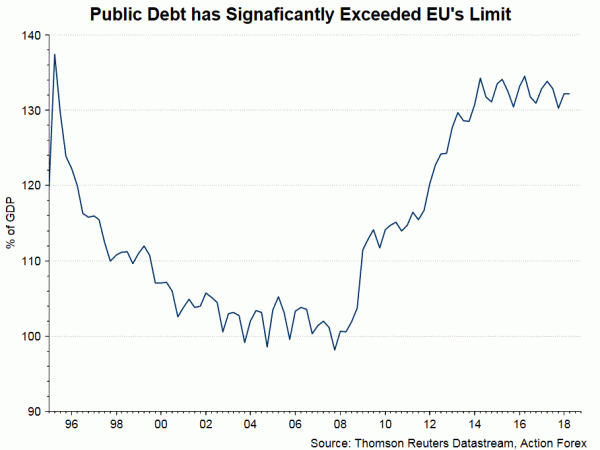(Update: The Italian government has announced that it would now set the budget deficit targets to 2.4% of GDP for 2019, 2.1% for 2020 and 1.8% for 2021. Given short-lived and fractious nature of Italian government, we view these targets with suspicion. Suggest to continue monitoring the debt problems of the country, movement of yields and signs of contagion to other European peripheries.)
Concerns over Italy’s aggressive fiscal stimulus plan eased modestly, after reports signaled that the populist coalition government would lower the budget deficit target to 2.2% of GDP for 2020 and 2% for 2021, from 2.4% indicated last week. While details of the plan remain uncertain until release of the Economic and Financial Document (DEF) scheduled for today, market volatility has already spiked last week after revelation that budget deficit would reach 2.4% of GDP over the coming 3 years.
Finance Minister Giovanni Tria has noted that he would strive to achieve a figure ranging from 1.6-2%. The former government had agreed with the European Commission that the deficit would shrink to 0.8% in 2019 and 0% in 2020, before recording surplus of 0.2% in 2021. Obviously, the market was unnerved by the situation, evidenced by the selloff of Italian bonds and decline in Italian equities, especially the banking sector. The concerns are centered on the budget’s noncompliance with EU’s Stability and Growth Pact (SGP) and likely credit rating downgrades.
Conflict with EU’s Stability and Growth Pact (SGP) Manageable
The headline deficit figure of 2.4% is well within SGP’s rule that a member state’s budget deficit cannot exceed 3% percent of its GDP. However, Italy’s debt-to-GDP ratio stands at an elevated level of 131%, the biggest in Eurozone after Greece and significantly violating another rule which suggests that member state’s national debt cannot exceed 60% of its GDP.
Meanwhile, Italy is required by the EU adopt reforms on structural budget balance, the cyclically adjusted budget balance excluding one‐offs, aiming to reduce the deficit by 0.3 percentage point in 2018 and 0.6 percentage point in 2019. It’s no-brainer for the EU to object the coalition government’s latest budget plan which clearly walking in an opposite direction of deficit reduction.
Note that the government would have to submit the draft budget plan to the European Commission (EC) by October 15. A decision on EC’s assessment due by November 30 could lead to the launch of Excessive Deficit Procedure, ending up with sanctions against Italy. Such consequence might result in further downgrades by credit rating agencies.
By deciding to go ahead with fiscal stimulus and announcing a high deficit projection, Italy has foreseen a confrontation with the EU. Yet, by keeping the deficit below the threshold of 3% of GDP, we believe the coalition government is carefully avoiding a full-blown breakup with the EU.
League’s chief economic adviser Claudio Borghi indeed attempted to downplay the negative sentiment last week, suggesting that the figures “are not written in stone”. There is room for adjustment in our opinion. Reports that Italy is planning to rein in its deficit plans reinforce that the government strives to avert full blown confrontation with the EU.
Credit Rating Downgrades a Real Concern
What we are more worried about is credit rating downgrades which can come in as soon as later this month. Downgrade seems unavoidable and this could make Italy’s rating just one notch above junk status.
S&P has scheduled a review announcement on October 26. A downgrade seems inevitable as S&P has projected a deficit of 1.7% in 2019. Moody’s review, scheduled in end-October, would also likely result in a downgrade given its deficit projection of 2.1% for 2019.
While these have largely been priced in the market, the consequence of further squeezing Italy borrowing cost and pushing its bond yields higher can be disastrous if the downgrade is more than one notch -junk status.
If just one of the top three agencies cut Italy’s rating to junk status, it could immediately shut the country from obtaining public funding, no matter how high the yields it offer in its bonds.
Luckily, we do not see for now this is likely to happen. Another positive note is that we have seen little sign of contagion so far (bonds yields of other peripheral countries have increased only slightly).
| Agency | rating | Outlook | Notch above Junk Grade | Last Review | Next Review |
| Fitch | BBB | Negative | 2 | Aug 31,18 | |
| Moody’s | Baa2 | Negative | 2 | May 25, 18 | End-Oct,18 |
| S&P | BBB | Stable | 2 | Apr 27, 18 | Oct 26,18 |
















